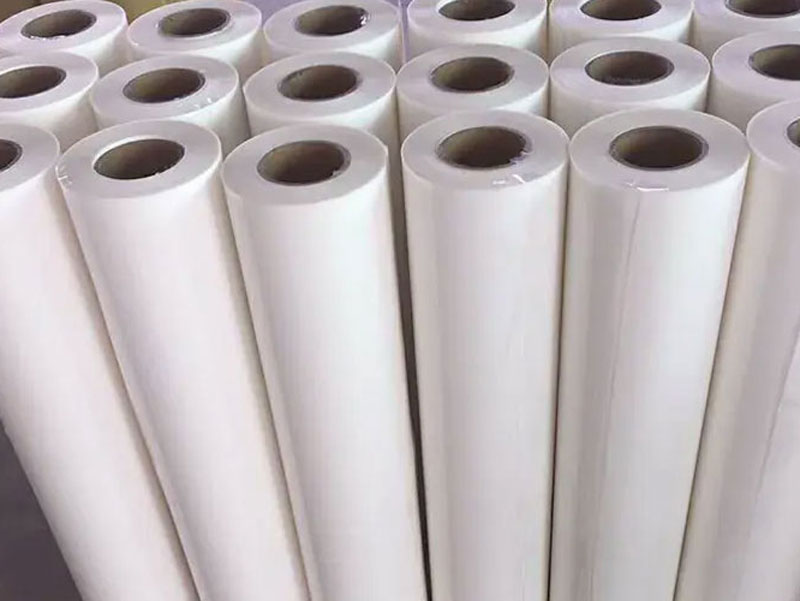In the evolving world of garment manufacturing, the pursuit of comfort, precision, and durability has led to the adoption of advanced bonding technologies. One such innovation that has revolutionized the apparel industry is polyolefin hot melt adhesive film. This versatile bonding material provides a clean, eco-friendly, and efficient alternative to traditional sewing, stitching, or liquid adhesives.
In this article, we’ll explore what polyolefin hot melt adhesive film is, its key advantages, and its wide-ranging applications within the apparel and textile industry.

What Is Polyolefin Hot Melt Adhesive Film?
Polyolefin hot melt adhesive film is a type of thermoplastic bonding film made primarily from polyolefin-based polymers such as polyethylene (PE) or polypropylene (PP). Unlike traditional liquid glues or stitching methods, this film provides a solid, uniform adhesive layer that melts when heated and forms a strong, flexible bond once cooled.
It is typically supplied in roll form and can be applied using heat pressing, lamination, or bonding machines. Because it does not require solvent drying or curing, it simplifies the bonding process and ensures a clean production environment.
Key Properties:
Excellent flexibility and softness
High bonding strength with various fabrics and substrates
Low melting temperature (usually between 90°C–130°C)
Good wash resistance and dry-clean stability
Environmentally friendly and solvent-free
These characteristics make polyolefin hot melt adhesive film a preferred bonding solution for modern apparel production.
Why the Apparel Industry Prefers Polyolefin Hot Melt Adhesive Film
The apparel industry is constantly seeking ways to improve fabric quality, enhance comfort, and streamline production. Traditional stitching, while reliable, has limitations—visible seams, fabric distortion, and water leakage in performance wear. Polyolefin hot melt adhesive film overcomes these challenges through seamless and flexible bonding.
Let’s take a closer look at why polyolefin hot melt adhesive film has become a go-to material for garment manufacturers.
1. Seamless and Comfortable Design
Consumers today value comfort and aesthetics. Using polyolefin hot melt adhesive film, manufacturers can bond fabrics without visible stitches, resulting in smooth, seamless garments. This technique is especially useful in underwear, sportswear, and outdoor clothing, where comfort against the skin is critical.
By eliminating bulky seams, the garment feels lighter, softer, and more ergonomic. The smooth surface also enhances the garment’s aesthetic appeal, making it look more premium and fashionable.
2. Strong and Flexible Bonding
Although it feels soft and lightweight, polyolefin hot melt adhesive film forms a strong and durable bond once activated by heat and pressure. It maintains flexibility even after repeated washing, stretching, or exposure to body movement.
This flexibility ensures that the fabric maintains its original drape and elasticity, a crucial feature for tight-fitting garments such as leggings, yoga pants, and athletic tops.
Unlike rigid adhesives, PO hot melt films move with the fabric instead of cracking or peeling.
3. Eco-Friendly and Solvent-Free
Sustainability is a growing focus in the fashion and textile industry. Traditional solvent-based adhesives release volatile organic compounds (VOCs) that harm both workers and the environment.
Polyolefin hot melt adhesive film is completely solvent-free and produces no harmful emissions during processing. It contributes to cleaner production lines and safer working conditions.
Moreover, many types of PO hot melt films are recyclable and compliant with environmental standards such as REACH, RoHS, and OEKO-TEX.
4. Simplified Production Process
In apparel manufacturing, time efficiency is crucial. Polyolefin hot melt adhesive film streamlines bonding operations significantly compared to stitching or liquid adhesives.
The process involves simply placing the adhesive film between two fabric layers, then applying heat and pressure through a hot press or bonding machine. Once cooled, a strong and clean bond is formed.
There’s no need for drying time or complex mixing, which greatly improves production efficiency and reduces labor costs. This simplicity makes polyolefin hot melt films ideal for mass production and automation in garment factories.
5. Excellent Wash and Heat Resistance
Garments bonded with polyolefin hot melt adhesive film can withstand repeated washing and drying without losing their adhesion. The adhesive remains stable under both hot and cold water conditions, making it suitable for daily wear, sports apparel, and professional uniforms.
Additionally, PO films are resistant to sweat, body oils, and mild detergents, ensuring long-term durability and product quality.
Applications of Polyolefin Hot Melt Adhesive Film in Apparel Production
The versatility of polyolefin hot melt adhesive film allows it to be used across various segments of the garment industry. Below are some of the most common applications:
1. Seamless Underwear and Lingerie
In seamless underwear manufacturing, traditional sewing can cause irritation or visible seams. Polyolefin hot melt adhesive film enables the creation of soft, flat seams that feel smooth against the skin. It bonds elastic bands, labels, and trims invisibly, enhancing comfort and style.
2. Sportswear and Activewear
Performance apparel requires flexibility, breathability, and strength. Using PO hot melt films, brands can bond fabrics such as spandex, nylon, and polyester with precision. The adhesive supports movement and stretch without compromising on bonding strength, making it ideal for yoga wear, cycling shorts, and compression garments.
3. Outdoor and Functional Clothing
For outdoor jackets, raincoats, and waterproof pants, polyolefin hot melt adhesive film offers water-resistant and weatherproof bonding. It is often used for seam sealing, logo attachment, and reflective tape bonding. Its durability ensures garments remain functional even under harsh outdoor conditions.
4. Fashion and Embellishment Applications
In fashion design, PO adhesive films enable creative applications such as bonding appliqués, decorative patches, and embroidery. Unlike liquid glue, it provides precise control with no residue or color staining, maintaining the fabric’s natural appearance.
5. Labels and Logos
Polyolefin hot melt adhesive film is also widely used for heat transfer labels and logos. It ensures that logos remain firmly attached after multiple washes while keeping the garment lightweight and comfortable.
6. Shoe and Accessory Bonding
Beyond apparel, PO hot melt adhesive film is used in bonding shoe uppers, linings, and textile accessories. Its low processing temperature protects delicate materials while maintaining strong adhesion.

Comparison: Polyolefin vs. Other Hot Melt Films
To better understand its advantages, let’s compare polyolefin hot melt adhesive film with other common adhesive films used in garments, such as TPU and EVA films.
| Feature | Polyolefin (PO) Film | TPU Film | EVA Film |
|---|---|---|---|
| Flexibility | Excellent | Excellent | Moderate |
| Wash Resistance | Very Good | Excellent | Average |
| Melting Temperature | Low (90–130°C) | Medium (120–160°C) | Low (80–120°C) |
| Eco-Friendliness | Solvent-free, recyclable | Solvent-free | Solvent-free |
| Cost | Cost-effective | Higher | Lower |
| Best Applications | Underwear, casualwear, lightweight fabrics | Sportswear, footwear | Temporary or low-cost bonding |
From the table, it’s clear that polyolefin hot melt adhesive film provides an excellent balance between performance, cost, and environmental sustainability, making it a top choice for lightweight garment bonding.
Processing Tips for Polyolefin Hot Melt Adhesive Film
To achieve optimal bonding performance, the following parameters should be considered during application:
Temperature Range: 100–130°C (depending on film grade and fabric type)
Pressure: 0.3–0.6 MPa
Dwell Time: 10–20 seconds
Cooling: Allow sufficient cooling before peeling or handling
Proper control of heat, pressure, and cooling ensures consistent bonding quality and prevents deformation or shrinkage of sensitive fabrics.
Conclusion
Polyolefin hot melt adhesive film has transformed how garments are made, providing apparel manufacturers with a reliable, eco-friendly, and efficient bonding solution. Whether it’s seamless underwear, high-performance sportswear, or elegant fashion garments, this film delivers unmatched comfort, durability, and design flexibility.
By embracing polyolefin hot melt adhesive film, the apparel industry is moving toward a future of cleaner production, superior comfort, and sustainable innovation—one bond at a time. Want to get more about hot melt adhesive film with wholesale prices? Welcome to contact Alster!
